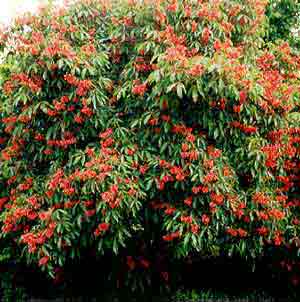 Red Buckeye - Aesculus pavia
Red Buckeye - Aesculus pavia
Buckeye Family (Hippocastanaceae)
- Native habitat: Southeastern U.S., from North Carolina through Eastern Texas and north to Illinois. Growth habit: Oval, round habit with moderate density. Although irregular when young, it becomes symmetrical with age. Texture is coarse.
- Tree size: Reaches a height of 15 to 20 feet, with a width of 15 to 25 feet. In the wild, grows to 30 to 35 feet tall. Growth rate is slow to moderate.
- Flower and fruit: Red, showy, tubular flowers are borne in 4- to 8-inch-long panicles. Fruit is a round capsule that is 1 to 2 inches in diameter and is dry, hard and orange-brown. The shiny nuts are toxic to humans.
 Leaf: Opposite, palmate, 3 to 6 inches long. Leaves emerge early in spring, are dark green in summer and offer little color change in fall. Leaves, which are toxic to discourage herbivory, usually drop in late September.
Leaf: Opposite, palmate, 3 to 6 inches long. Leaves emerge early in spring, are dark green in summer and offer little color change in fall. Leaves, which are toxic to discourage herbivory, usually drop in late September.- Hardiness: Winter hardy to USDA Zone 4.
 Additional information:
Additional information:Its bright flowers, light brown, flaky bark and coarse open structure are excellent ornamental features of red buckeye. The tree's attraction of hummingbirds and butterflies makes it appealing to people who want to attract wildlife. The toxicity of its fruit should be considered when locating red buckeye. Eating the shiny nuts, especially attractive to children, causes kidney failure. Also, its fruit can be quite abundant, causing litter problems along with its twigs and foliage.
 Red buckeye was the winner of a 1995 Pennsylvania Horticulture Society Gold Medal Plant award. Red buckeye can be grown with multiple trunks or pruned to have a single trunk. Its branches need to be pruned if clearance is desired.
Red buckeye was the winner of a 1995 Pennsylvania Horticulture Society Gold Medal Plant award. Red buckeye can be grown with multiple trunks or pruned to have a single trunk. Its branches need to be pruned if clearance is desired.
The largest recorded red buckeyeis in Kalamazoo County, Michigan, beyond the tree's natural range. It is 64 feet tall with a diameter of 2 feet, 5 inches.


